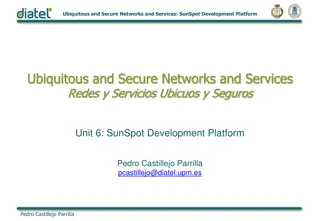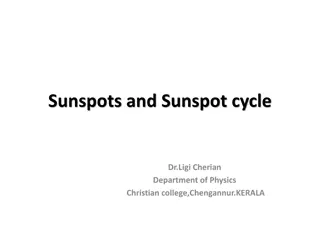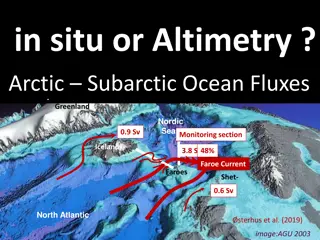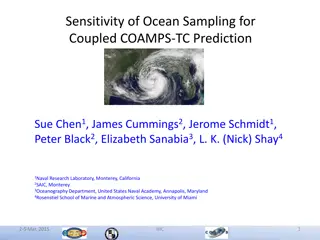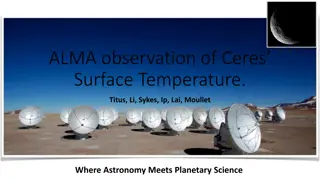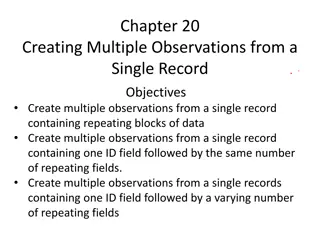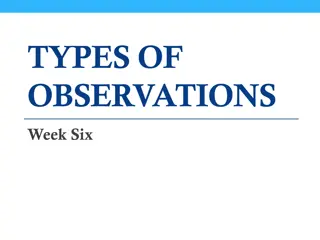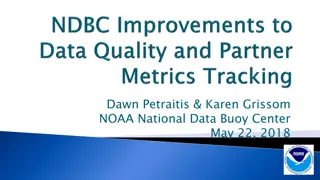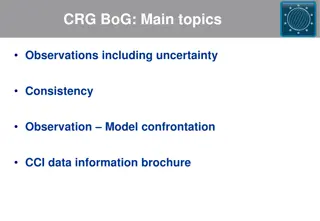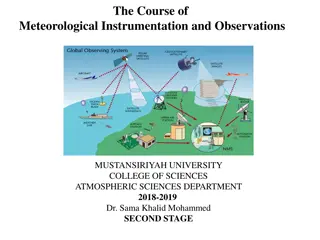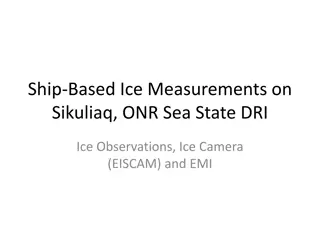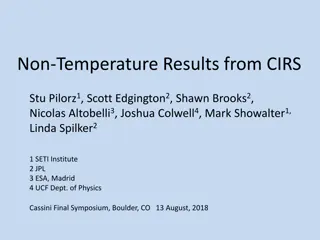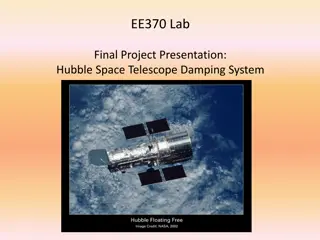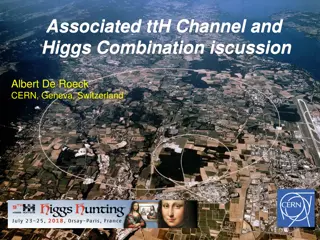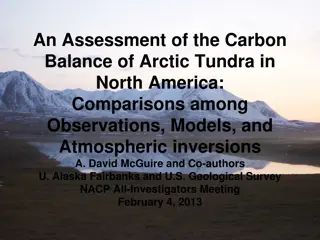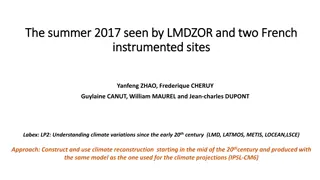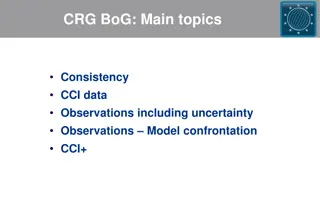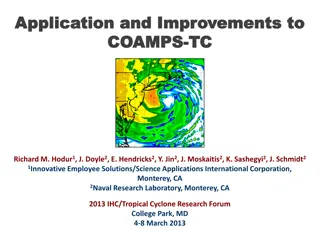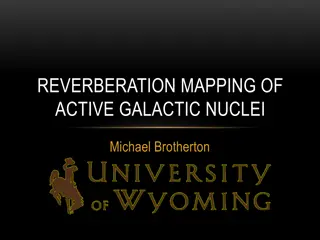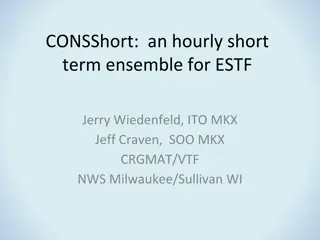Sunspot Observations of Ruđer Bošković in 1777
Ruđer Bošković, a renowned Croatian scientist, conducted sunspot observations in 1777 near Paris using innovative methods. This paper aims to analyze and process his observations to determine the elements of the Sun's rotation and period, providing valuable data on solar magnetic activity. Bošković's diverse interests and achievements in mathematics, science, and philosophy further highlight his significance in history.
Download Presentation

Please find below an Image/Link to download the presentation.
The content on the website is provided AS IS for your information and personal use only. It may not be sold, licensed, or shared on other websites without obtaining consent from the author. Download presentation by click this link. If you encounter any issues during the download, it is possible that the publisher has removed the file from their server.
E N D
Presentation Transcript
Ruer Ru er Bo kovi 's Bo kovi 's Sunspot Observations in 1777 Observations in 1777 Sunspot D. Ro a1, D. Hr ina1, M. Husak2, R. Braj a3, D. poljari 3, I. Skoki 3, D. Mari i 1, F. terc1, I. Rom tajn1 1Zagreb Astronomical Observatory, Zagreb, Croatia 2Trako anska 20, 42000 Vara din, Croatia, https://orcid.org/0000-0002-2814-5119 3Geodetski fakultet Sveu ili ta u Zagrebu, Opservatorij Hvar, Fra Andrije Ka i a Mio i a 26, 10000 Zagreb, Croatia E-mail: drosa@zvjezdarnica.hr
Croatian dinar transitional currency introduced following Croatia's declaration of independence Crater named after Croatian physicist Ru er Bo kovi Ru er Ru erBo kovi Bo kovi (1711 - 1787) one of the most famous Croatian scientists The name of our largest resarch institute in honours the Ru er Bo kovi
Ruer Bokovi had broad interests and achievements in mathematics, science, civil engineering, philosophy, as well as in poetry and diplomacy His famous work: Philosophi naturalis theoria redacta ad unicam legem virium in natura existentium (Theory of Natural philosophy derived to the single Law of forces which exist in Nature), containing Bo kovi s atomic theory and theory of forces (1. ed. Vienna 1758) main research field was astronomy developed several methods for the determination of the solar rotation elements and the rotational period of the Sun De maculis solaribus (1736) (On Sunspots) applied the methods to his own sunspot observations made in 1777 in Noslon near Sens, 120 km south from Paris
The main goal of this paper - analysis of a part of Bokovi's observation of sunspots and calculation the elements of the Sun's rotation and period with modern methods and ephemeris data. Significance in addition to historical significance, also scientifically valuable data on the Sun's differential rotation, which plays a significant role in generating and maintaining solar magnetic activity. Analysis of observational data Derivation the expressions needed to calculate the elements of the Sun's rotation and period from observations Processing of the Bo kovi 's original observation
Observational data - topocentric ecliptic latitude 'fand topocentric ecliptic longitude 'f N optical micrometre determination of the declination (difference between the declination of the sunspot ( f) and the declination ( S) of the centre of the solar disk) d sunspot f pendulum for time measurement determination the right ascension of the sunspot ( f) E W C d = + f S cos f From the and , we can easily calculate topocentric ecliptic coordinates of the sunspot (topocentric ecliptic latitude 'fand topocentric ecliptic longitude 'f): S Figure 1: drawing of a solar disk with the position of a single spot. Line WE is parallel to the plane of the equator and is easily determined from observations. = = = sin ' cos sin cos sin sin cos , cos sin , f f f f ' cos ' cos cos cos sin f ' sin ' f f f + cos sin , f f f f f where is the obliquity of the ecliptic.
Expressions needed to find the elements of the Sun's rotation and period from observations 1. Transformation topocentric ecliptic coordinates of the sunspot ( 'f, 'f) to heliocentric ecliptic coordinates ( S, S) The apparent angular and rectangular topocentric coordinates of the Sun (( 'S, 'S) and (xS, yS, zS)) as well as the current distance to the Sun can be determined using some of the ephemeris. d ' 180 = heliocentric angular distance between the sunspot and observer is: sin observer-S r S heliocentric rectangular ecliptic coordinates of the sunspot (xf, yf, zf) are: cos ' cos sin ' cos sin ' z d = sunspot = = ' ' x y d d x y f f-S f f S rS f f-S f f S ' z f f-S f S Sun centre observer heliocentric ecliptic coordinates of the sunspot ( S, S): Figure 2: with known distance between observer and the Sun (dobserver- S), apparent angular distance between centre of the Sun and sunspot ( ) and Solar radius (rS), angle ( ') can be determined, as well as heliocentric coordinates of sunspot. z r x y = arcsin f f S = arctan f f f
2. Transformation heliocentric ecliptic coordinates (S, S) to heliographic (b, l) Determination of the solar rotation elements and period The direction of the solar axis in space is determined by: inclination (i) - the angle between the ecliptic plane and the solar equatorial plane and ecliptic longitude ( ) of the ascending node of the solar equator - the angle, in the ecliptic plane, between the equinox direction and the direction where the solar equator intersects the ecliptic from the South, i.e. in the sense of rotation. P0 90 +( ) i 90 l PS + cos sin = cos cos sin X Y Z X = sinb/cosi, Y = cos tani and Z = sin tani X we need to have at least three observations of a sunspot ( ) b = arcsin cos b X i Z Y = x arctan ) ( X = + 2 2 arctan i Y Z l X x sin tan cos i ( ) i = + tan cos tan i . l X ( ) N
Bokovi's measurements Right ascension is directly given by measured time of contacts (time that elapsed from the moment when Sun was in upper culmination in Sens, France.) Distance in declination from northern edge of the Sun was measured by use of micrometer 6 days of observations (between 12 and 19 September 1777) of the same sunspot with set of 5 measurements each day of observation solar rotation elements: b = 26.43 , = 65.61 , i = 7.88 sidereal period (using least square method) is P = (26.696 0.044) days ( = (13.485 0.022) /day) which corresponds to mean value of the synodic period of P = 28.780 days ( = 12.508 /day). In calculation of the sidereal period from synodic we used mean angular heliocentric velocity of the Earth (0,9765 /day) during period between 12 and 19 September 1777. Bo kovi 's results for sidereal period is 26.77 days and it is close to the our result.
Comment: A 12. Sept. 1777. bord boreal 561 555 559 563 559 Milieu " 3 51 12 559.4 h 2 3 3 ' " 9 h 3 3 3 ' " h 3 3 3 ' " h 3 3 3 ' " h 3 3 3 ' t1 tt t2 B 1 bord.. tache.. 2 bord.. 59 6 8 8 42 29 50 10 12 12 32 20 40 14 16 16 27 14 35 22 23 25 0 1 55 16 Diff rence 42.5 43.0 44.0 43.0 43.5 milieu 43.2 13. Sept. 1777. bord boreal 526 524 521 527 524 Milieu " 11 49 21 524.4 h 2 2 2 ' " 4 h 2 2 2 ' " h 2 2 2 ' " h 2 2 2 ' " h 2 2 2 ' 1 bord.. tache.. 2 bord.. 33 34 35 35 37 37 44 21 52 39 41 41 48 25 56 42 44 44 33 11 41 50 51 52 41 11 Diff rence 33.5 33.0 33.0 34.0 33.0 milieu 33.3 15. Sept. 1777. bord boreal 440 440 440 440 440 Milieu " 16 32 24 440.0 h 3 3 3 ' " h 3 3 3 ' " 8 h 3 3 3 ' " h 3 3 3 ' " h 3 3 3 ' 1 bord.. tache.. 2 bord.. 6 7 8 42 57 50 14 15 16 17 19 19 45 20 22 22 48 34 25 26 23 15 0 4 53 56 Diff rence 11.0 11.0 11.0 12.0 12.0 milieu 11.4 16. Sept. 1777. bord boreal 388 388 389 390 388 Milieu " 3 8 12 388.6 h 3 3 3 ' " h 3 3 3 ' " h 3 3 3 ' " h 3 3 3 ' " h 3 3 3 ' 1 bord.. tache.. 2 bord.. 42 43 44 35 39 43 45 46 47 29 33 37 48 49 50 22 25 30 51 52 53 19 23 27 54 55 56 Diff rence 0.0 0.0 -1.0 0.0 1.0 milieu 0 17. Sept. 1777. bord boreal 331 332 334 334 331 Milieu " 12 7 20 332.4 h 3 3 3 ' " 0 h 3 3 3 ' " h 3 3 3 ' " h 3 3 3 ' " h 3 3 3 ' 1 bord.. tache.. 2 bord.. 18 18 20 24 25 26 23 16 30 28 29 30 12 31 32 33 21 15 29 35 36 37 53 6 7 19 Diff rence -10.5 -10.5 -9.5 -10.0 -9.0 milieu -9.9 19. Sept. 1777. bord boreal 239 241 240 240 240 Milieu " 43 19 51 -28.0 240.0 h 2 2 2 ' " h 2 2 2 ' " h 2 2 2 ' " h 2 2 2 ' " h 2 2 2 ' 1 bord.. tache.. 2 bord.. Diff rence 34 35 36 26 37 37 39 14 50 22 41 42 43 51 26 59 43 44 45 47 23 55 46 47 48 3 34 -27.0 -28.0 -29.0 -28.0 milieu -28
Conclusions This paper presents an analysis of a part of Bo kovi 's observations of sunspots with a presented mathematical approach and with the use of modern ephemeris parameters. The obtained values for the solar rotation parameters and the rotation period are close to Bo kovi 's results, which indicates the accuracy of Bo kovi 's methods. Furthermore, we plan to extend the processing to all of Bo kovi 's observations and compare them with the results of other historical and modern measurements.


